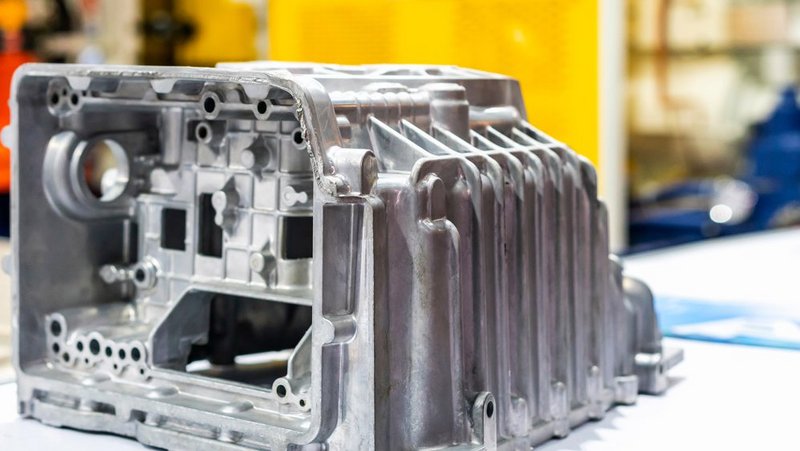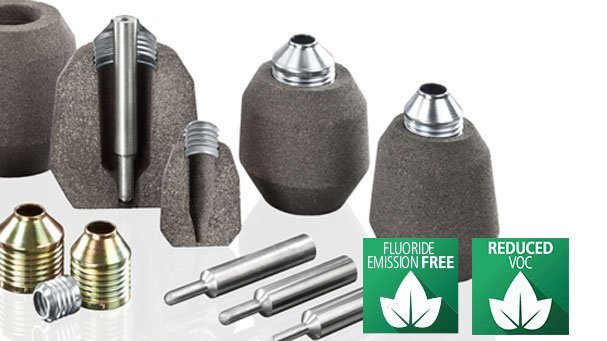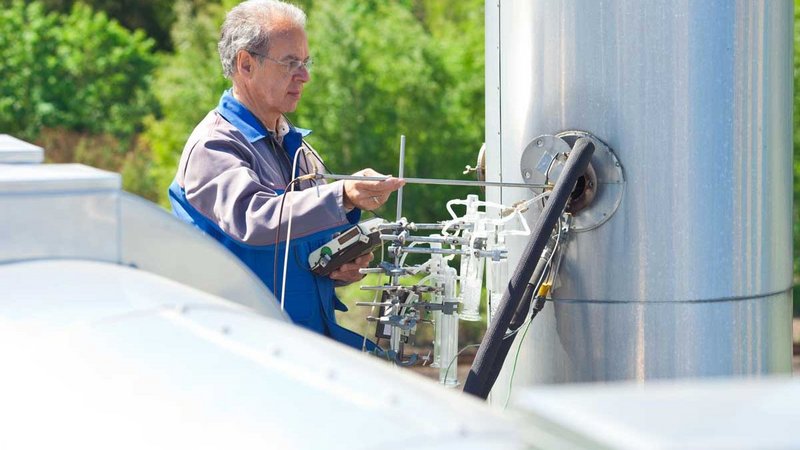
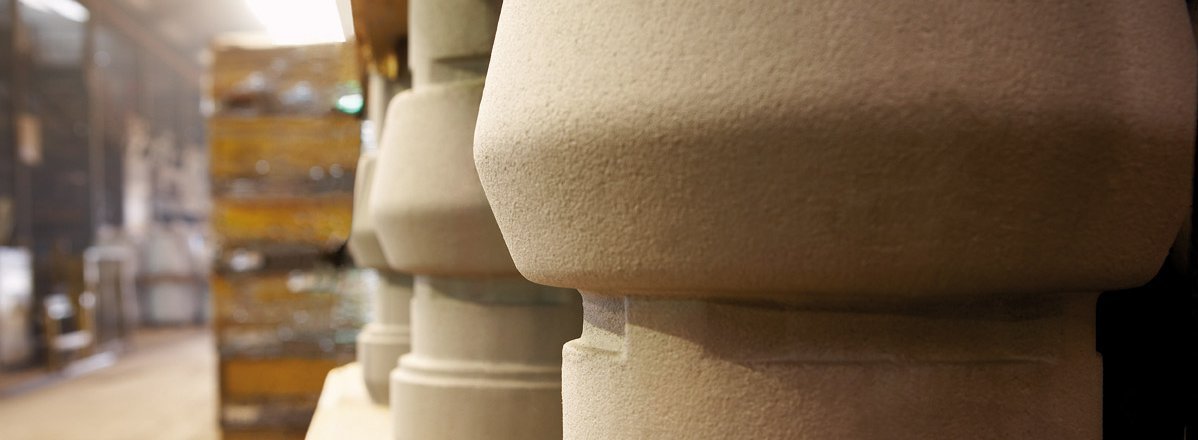
Chemically-bonded sand casting / Resin bonded sand casting
What is chemically-bonded sand casting?
Developed through the 20th Century, chemical-bonded, or resin-bonded, sand casting refers to casting processes that utilise chemically-bonded sand moulds and cores, instead of the clay-bonded systems used in green sand casting.
Chemical-bonded moulding systems fall into two basic categories: self-hardening (also known as no bake, self-set or cold-set) and triggered-hardening. The latter includes both heat-activated and gas-triggered systems.
Heat-activated systems saw much development in the mid-20th Century, when a number of processes were developed that replaced older oil-bonded methods. By the mid-1970s, however, the gas-triggered cold-box system was firmly establishing itself as a faster and less environmentally-burdensome process for core and mould making. Since then, self-hardening and cold gas-triggered systems have taken an ever-expanding share of the chemical-bonded sand casting market.
Pre-hardening the moulds and cores ahead casting allows the production of dimensionally precise castings, compared to green sand casting, where the mould it hardened during casting. These hardened moulds and cores can be automatically assembled on continuous conveyor lines to be cast. In this way, highly complex components can be cast. Once assembled, moulds can either be bottom-filled with the molten metal, to eliminate oxide inclusions and reduce running system turbulence, or via direct top pouring.
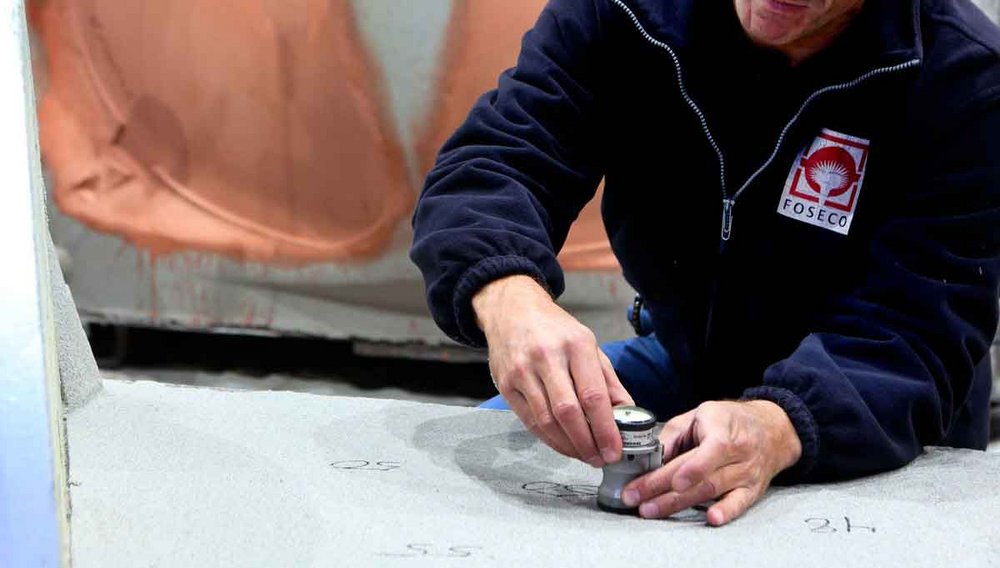
The two basic types of chemical-bonded moulding systems
- Self-hardening mixes comprise sand, a binder and a hardening chemical. The latter two components react and slowly begin to harden as the sand is formed into the mould or core. The hardening continues until the sufficient strength has been gained for casting.
- Triggered-hardening systems involve pre-forming the sand-binder mix to the requisite pattern in a core box, and then applying heat or a catalytic gas to activate the hardening process. Once activated, hardening occurs quickly.
Within these general categories, however, there are a various techniques available. Development efforts to improve binding systems, particularly to control and reduce the release of harmful gases during mould production and casting, as well as to improve sand reclamation rates, is also ongoing.
Self-set moulding systems
Furane-based binding systems
Developed as far back as the 1950s, furane-based no-bake systems use a furane resin with an acidic hardening chemical. Furan-bonded moulds have good hot strength and erosion resistance, and are relatively easy to reclaim. The curing speed is also easy to control via the percentage and strength of the acid used. On a more challenging note, however, formaldehyde – the subject of tightening regulation in some regions, notably the EU – is released from the mixed sand. When sulphonic acids are used as the hardening agent, sulphur dioxide gas is also released when the mould is cast.
Modern furane moulding systems are designed to counter the challenge posed by hazardous emissions. ESHANOL and FUROTEC furane binders from Foseco, for example, have been formulated for very low emissions during application and pouring. Both also offer very high binding characteristics to ensure the lower possible additions (<1%) are required to product good-quality moulds and cores. Meanwhile, CATASET acidic catalysts are also designed for minimum addition rates, as well as for optimisable bench life and curing time to foundry requirements.
Urethane-based binding systems
A patent for a phenolic-urethane binder system was first filed in 1978 by Ashland Oil Inc., in the US. More expensive than furan binders, urethane binder systems traditionally come in three parts, comprising a phenolic-urethane resin, an isocyanate (e.g., methylene diphenyl diisocyanate, MDI), and a liquid amine catalyst; two-part systems are also now available.
Originally urethane binders were based on aromatic organic solvents, which resulted in very high fume emissions on mixing and the release of an acrid smoke during casting. However, low-odour polyurethane cold-set binders have now been developed, such as POLISET from Foseco, extending the market for urethane-binding systems:
- POLISET AL is a two-component binder system developed for aluminium casting that utilizes non-aromatic solvents and low-phenol and -formaldehyde binders to deliver rapid strength development, as well as excellent post-casting breakdown.
- POLISET E is a three-component phenolic binder system, suitable for both ferrous and non-ferrous casting applications, that offers flexible set times (2 – 30 minutes) and excellent hot strength (low erosion defects and good dimensional accuracy).
Ester-hardened alkaline phenolic moulding systems
Ester-hardened alkaline phenolic resins were developed in the late 1970s and early 1980s (e.g., this patent, filed by Borden UK Ltd in 1982), but began to gain in prominence at the turn of the Millennium when more focus was placed on developing safer and more environmentally-friendly binder systems. Modern systems, such as FENOTEC from Foseco, comprise a water-soluble alkaline phenolic resin with a range of liquid organic ester activation agents, and combine good stripping and casting finish with low fume emissions during mixing, casting and knockout.
FENOTEC is a flexible binding solution, being suitable for both mould and core production, casting of a wide range of alloys, and with a range of sands (silica, chromite, zircon and olivine: for more on the different sand types, see our discussion of green sand moulding). It may also be used as a gas-triggered system in which the ester is added as a vapour and blown through the sand-resin mix.
Heated (baked) moulding systems
As the name suggests, heated mould-making processes involve the application of heat to activate and cure the binder. These processes require metal cure boxes and patterns, which are evenly heated via gas burners or electric-heated elements. Initially popular, their use has waned in favour of self-set and cold-set processes, which eliminate the financial, health and safety, and environmental costs inherent in any heated process. Ensuring adequate heat penetration is also a challenge when utilizing thicker moulds and cores.
- The Croning® (or shell) process was developed by the German inventor, Johannes Croning, in the 1940s and involves precoating the sand with a phenolic novalak resin and catalyst. Compared to others, it is a relatively slow process, but achieves excellent surface finish and dimensional accuracy.
- In contrast, the hot box process involves a liquid formaldehyde-based resin and catalyst. The hot box process was the first high-speed resin core making process to be developed, and offers good surface hardness, strength in thin sections and breakdown.
- As the name suggests, the warm box is a lower-temperature variant of the hot box, using a high-furfuryl alcohol binder. Warm box cores are used when high strength and resistance to veining is required.
Gas-triggered (cold box) moulding systems
The classic cold box process
Developed in the 1960s and refined through the 1970s with the introduction of a humidity-resistant cold box system, the classic gas-triggered – or cold box – moulding system utilizes a two-part binder (comprising a phenolic-urethane resin and polyisocyanate, such as MDI). The binding agents are mixed with the sand and blown into a mould/core box. An amine gas is the blown into the box, catalysing a reaction between the two components of the binder and causing almost instantaneous hardening.
Modern polyurethane cold box binders, such as the POLITEC range from Foseco, have been developed to reduce the harmful emissions that are inherent in the traditional cold box system, reducing the use of aromatic solvents and organics. The POLITEC E range, for example, has been formulated to meet the most stringent technical and environmental requirement, incorporating non-aromatic solvents to reduce both odour and emissions.
Other gas-based systems
Carbon dioxide (CO2)- and sulphur dioxide (SO2)-based systems offer alternatives to amine-based processes. The ECOLOTEC water-based resole CO2 process from Foseco, for example, uses a water-soluble phenolic resin that has been condensed under alkaline conditions. This resin is free of nitrogen, phosphorus and sulphur (all of which can be detrimental to casting quality) and is the only component that has to be mixed with the sand. Once in the core box, the sand-binder mix is gassed with CO2, which reacts with the resin to harden the mix.
The ECOLOTEC process is one of the most environmentally-friendly and safest gas-cured processes available, being non-flammable; low in both free phenol and formaldehyde; and free of isocyanates, peroxides, amines or sulphur-based compounds. It therefore reduces the release of noxious fumes during mixing and core-making. It can be used with all sand types, and does not require the use of coatings. It is particularly attractive for the creation of larger cores and moulds for iron, steel and aluminium castings.
SO2 is used in epoxy acrylic cold box systems. As in the ECOLOTEC process described above, coatings are not usually required to produce a good surface finish. Breakdown is good for both ferrous and aluminium castings. Recent advances have seen N2 blended with the SO2 to reduce core residues and environmental impact of the process; superheating this blended gas has also been discovered to reduce gassing times and increase core tensile strength.
Sodium silicate-bonded sand systems
A final process to note involve the use of sodium silicates as the binding agent. These harden when exposed to a number of chemicals, but in the foundry industry are most commonly used with weak acids – either CO2 gas or liquid organic esters. Sodium silicate binders, such as CARSIL and SOLOSIL from Foseco, have no smell and are not hazardous to worker health; they have thus undergone something of a resurgence in recent years in both ferrous and non-ferrous foundries, driven by the need to reduce (and in some cases, avoid) harmful emissions associated with resin-based binding systems.
Sodium silicate binders do not, however, offer as high a bond strength as resin binders. The bond – which is inorganic, as opposed to the organic bonds created by resins – also does not break down with heat, making its post-casting removal more of a challenge. This often requires the addition of organics, such as the VELOSET range of ester-based additives for CARSIL-bonded sands, to facilitate shake-out. VELOSET additives also significantly enhance bond strength and sand reclamation rates.
Can chemically-bonded sand be reclaimed?
It depends. There is no doubt that reclaiming chemically-bonded sand is more challenging than in green sand casting; however, modern binding systems are being developed and refined to allow reclamation with high reclamation rates now possible, e.g., with FENOTEC self-set binders, and POLISET cold-set binders. This is any area of ongoing research and development, however, and further advances in this area are to be expected.
Want to know more?
Foseco is a leading global supplier of consumables to foundries using the resin sand casting process. Our knowledgeable staff can assist you in selecting from a wide range of resins to find the most suitable product for your specifications. If you are interested in more information about our products, please contact our team of experts.
- Suitable for most ferrous and non-ferrous metals and alloys
- Excellent dimensional accuracy and surface finish
- Reduces casting defects including sand holes, air holes and shrinkage
- Shell moulds are lightweight and, once cured, can be stored indefinitely
- Can be used to produce very large castings
- Sand-binder mixes have a limited shelf life
- Requires specialized mixing and moulding equipment
- Chemical binders are expensive
- Many processes involve handling hazardous chemicals, and result in harmful emissions
Foseco products for foundries using chemically-bonded sand casting
- High exothermic spot feeder sleeves
- Exothermic-insulating feeder sleeves
- Insulating sleeves
- Direct pour technology
- Coatings for high production cores
- Coatings for jobbing cores and moulds
- Equipment to apply coatings
- Speciality coatings
- Filters for steel castings
- Filters for iron castings
- Filters for aluminium and copper castings
- Self-setting resins
- Gas-setting resins
- Moulding material
Note
Croning® is a registered trademark of ACTech GmbH.
Further reading
Brown, J.R. (ed.), Foseco Ferrous Foundryman’s Handbook (Butterworth Heinemann; 2000), Chapter 12: Sands and green sand, pp. 146-166.
Brown, J.R. (ed.), Foseco Non-Ferrous Foundryman’s Handbook (Butterworth Heinemann; 2000), Chapter 12: Sands and sand bonding systems, pp. 149-166


